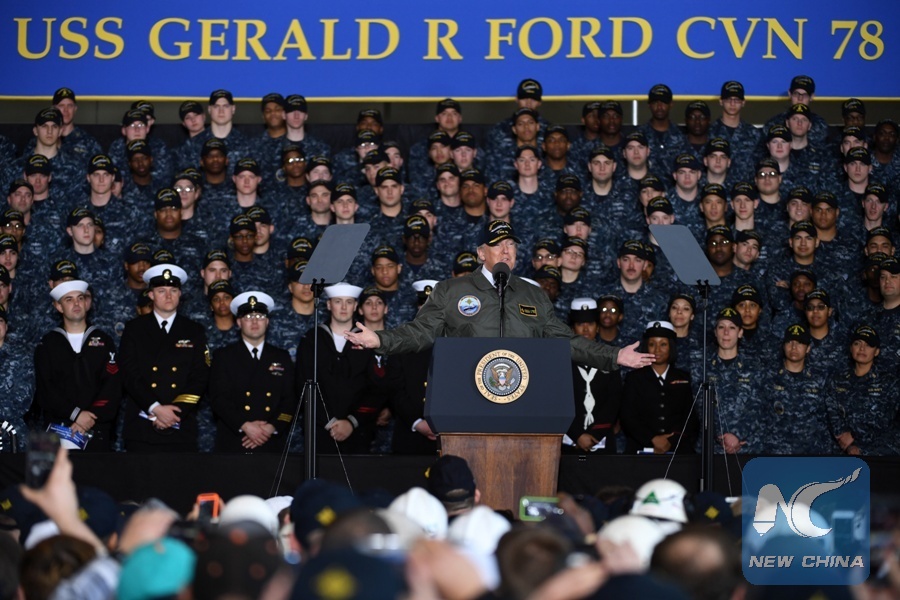
File Photo: U.S. President Donald Trump delivers remarks aboard the pre-commissioned U.S. Navy aircraft carrier Gerald R. Ford in Newport News, Virginia, the United States, March 2, 2017. (Xinhua/Yin Bogu)
WASHINGTON, Jan. 16 (Xinhua) -- The Donald Trump administration's large-scale hike in the defense budget, calling it a pillar of the U.S. president's "Make America Great Again" vision, indicates the United States is readying a bigger money chest for defense under Trump but the question is whether it is feasible.
"American might is second to none and we're getting bigger and better and stronger every day," Trump declared in the hangar bay of aircraft carrier Gerald R. Ford on July 22, 2017, as thousands cheered.
"Wherever this vessel cuts through the horizon, our allies will rest easy and our enemies will shake with fear because everyone will know that America is coming, and America is coming strong," Trump said when the carrier, one of the most powerful hardware items to be added to the U.S. military's arsenal, was commissioned.
Six months after assuming office, Trump paid a second visit to the vessel, where he touted the ship's power, taunted America's enemies, and promised full backing for a stronger military.
It was no empty talk. The United States already had the world's most powerful military, and now, with Trump's blessings, Congress has approved a whopping 700 billion-U.S.-dollar defense budget in fiscal year 2018, a 100-billion-dollar increase from 2017.
Though the approved figure has surpassed a cap of 549 billion dollars imposed by the 2011 Budget Control Act and may be blocked, it's clear that Congress is preparing a bigger money chest for defense under Trump.
Each of the military branches will be sharing the bonus.
For the army, the money means 17,000 more recruits in 2018, and there are financial incentives to retain those already in service.
For the navy, the extra cash can help Washington get closer to its goal of expanding the number of its fleets from 270 to 355 in the next few decades.
For the air force, the bigger check can go a long way in procuring stealth fighter aircraft, the F-35s, whose unit price sank below 100 million dollars in 2017 for the first time.
The National Security Strategy, released in December, outlines the government's military and foreign policies.
According to the document, the United States will keep combating extremist groups in Afghanistan, Iraq and Syria, prepare for possible conflicts with the Democratic People's Republic of Korea over its development of nuclear weapons, and keep up the pressure on Iran, with whom Washington's relationship became increasingly adversarial in the past year.
Trump's actions follow his campaign promise in 2016 to prioritize military build-up. But unlike many of his other initiatives, beefing up the military has, by and large, won the support of lawmakers across the aisle. Republicans in both the House and Senate allowed more budget than the White House's demand.
Trump's arguments for more defense spendings were in part supported by government reports which said some units, such as the navy's Seventh Fleet, are suffering from insufficient training and rest.
A report released by the Heritage Foundation, a conservative think tank, says there are holes in the military that need to be patched in order for the United States to be able to simultaneously engage in two regional conflicts.
The Pentagon is due to release the National Defense Strategy, the Ballistic Missile Defense Review, as well as the Nuclear Posture Review in the coming weeks.
Despite charging ahead with his ambitious blueprint, Trump is also encountering tough headwinds. Skeptics have pointed out that with the proposed steep tax cut, it would be difficult to allocate enough money for the military's lavish purchasing list.
"If all Trump wanted was a big defense increase, he could have had it, but he also wanted tax cuts, entitlement reform and infrastructure investment. Something had to give, and usually in peacetime what gives is military spending," Loren Thompson, a defense consultant, told Politico.com.
Military top brass such as Navy Secretary Richard Spencer have also expressed concern.
"At the end of the day, this is all about math. You don't want to raise taxes. You don't want to cut benefits, and we want to grow the military. It is literally impossible. The math says you can't do it," Spencer told Politico.

